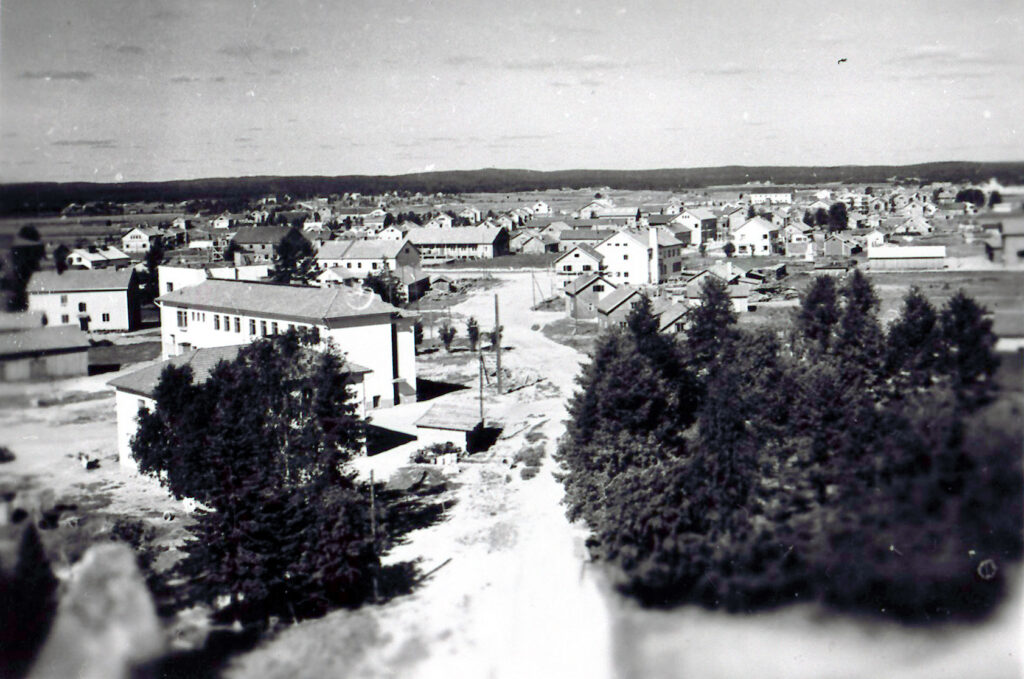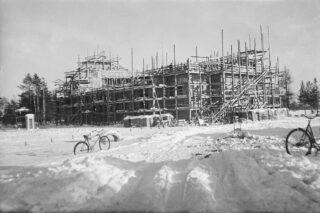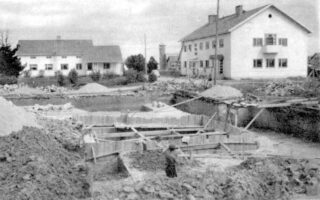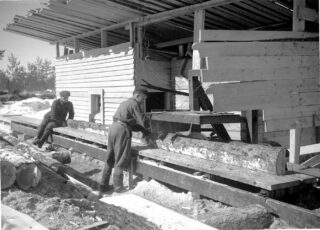The first task for Kuusamo residents returning home from evacuation was to find a roof over their heads. The luckiest were the residents of the villages, whose homes had not been destroyed and thus were soon able to live in their homes. Most of the people returning from evacuation had to urgently start building a new home to replace the destroyed one.
Many had to live in basements or temporary barracks at first. Public institutions also operated in barracks, such as the church and hospital, as well as most shops in the church town. Many families in the church town lived for a long time in dugouts built by the Soviet soldiers who occupied Kuusamo until November 1944. Such were in several places, such as Lahdentaus, next to the new cemetery by the River Nilojoki and in Toranginmäki.
However, new buildings were completed quickly. By 1947, most families had a new home. The church town got a new look. Along the roads Kitkantie and Ouluntie, there was a long row of one-and-a-half-story town houses or two-story commercial buildings built according to type drawings, equipped with drinking water and outdoor toilets.
At the core of the village, “Neljäntienristeys” (four-street-crossroad), there were commercial premises for the Kuusamo Osuuskauppa co-op and Oulu Osuuskauppa co-op pursuing the idea of a department store, with their own departments for different products. Also under construction were a church town school representing pure funk architecture and a church next door on the site of a former sanctuary burned in the war.
Many villages, where the destruction of the war was smaller than in the church town, were the first to recover. The villagers were thus able to concentrate on livestock and other everyday work. Many branch stores of various shops were also soon established in the villages.
The Great Partition of Kuusamo, which had been pending for a hundred years, was always delayed for various reasons. It started in 1951 and was completed in stages in 1961. Farmers, whose farming plots were often tens of kilometres away from their home plot, were given their own land in more uniform plots, mostly near their place of residence. In this way, uniform spaces were formed, which offered the possibility for more efficient farming. The farms also had their own forests and the opportunity to sell wood.
In Kuusamo, large-scale clearing of fields and felling of forests started. Agriculture was mechanized. A tractor and other agricultural machines were purchased for almost every farm with forest revenues. With the Great Partition, the parish was also electrified. Most cattle farms soon had a milking machine. Roads were built, which brought many villages closer to the centre.
At the same time as the Great Partition, the Kuusamo cooperative Osuusmeijeri dairy was established. When the road was in condition for year-round driving, the dairy’s cars picked up milk daily directly from the farms’ milk docks. The farmers now received a regular milk account once a month. It increased their purchasing power and practically put an end to the natural economy that had prevailed until now. This is how Kuusamo moved into the monetary economy. Mondays, when the milk bills were paid, were busy in the church town, when farmers from the villages came to make purchases from the shops, at first with scheduled post trucks, later with their own cars.
Kuusamo grew rapidly from the 1950s onwards. In the middle of the next decade, the population of the parish was more than 20 000 people, mostly because of natural growth. The families had many children and there was a folk school in every village.



